NUR09714 - LTAP Module: Supporting Underachieving Nursing Students
VerifiedAdded on 2023/06/09
|21
|5115
|151
Case Study
AI Summary
This case study examines the mentoring of an underachieving second-year nursing student during a 5-week clinical placement in an orthopaedic ward. The mentor, with 15 years of experience, develops learning, teaching, and assessment strategies to support the student's success. The study discusses the characteristics of underachieving students, the role of a mentor, different learning styles (VAK), the impact of the clinical environment, and the importance of feedback. Learning theories such as pedagogy, andragogy, cognitive, and behavioral theories are explored in relation to their application in improving the student's learning process. The case study concludes with a reflection on how the learning gained will apply to future mentoring practices, emphasizing the importance of a supportive and resourceful clinical environment. Desklib provides solved assignments and past papers for students.
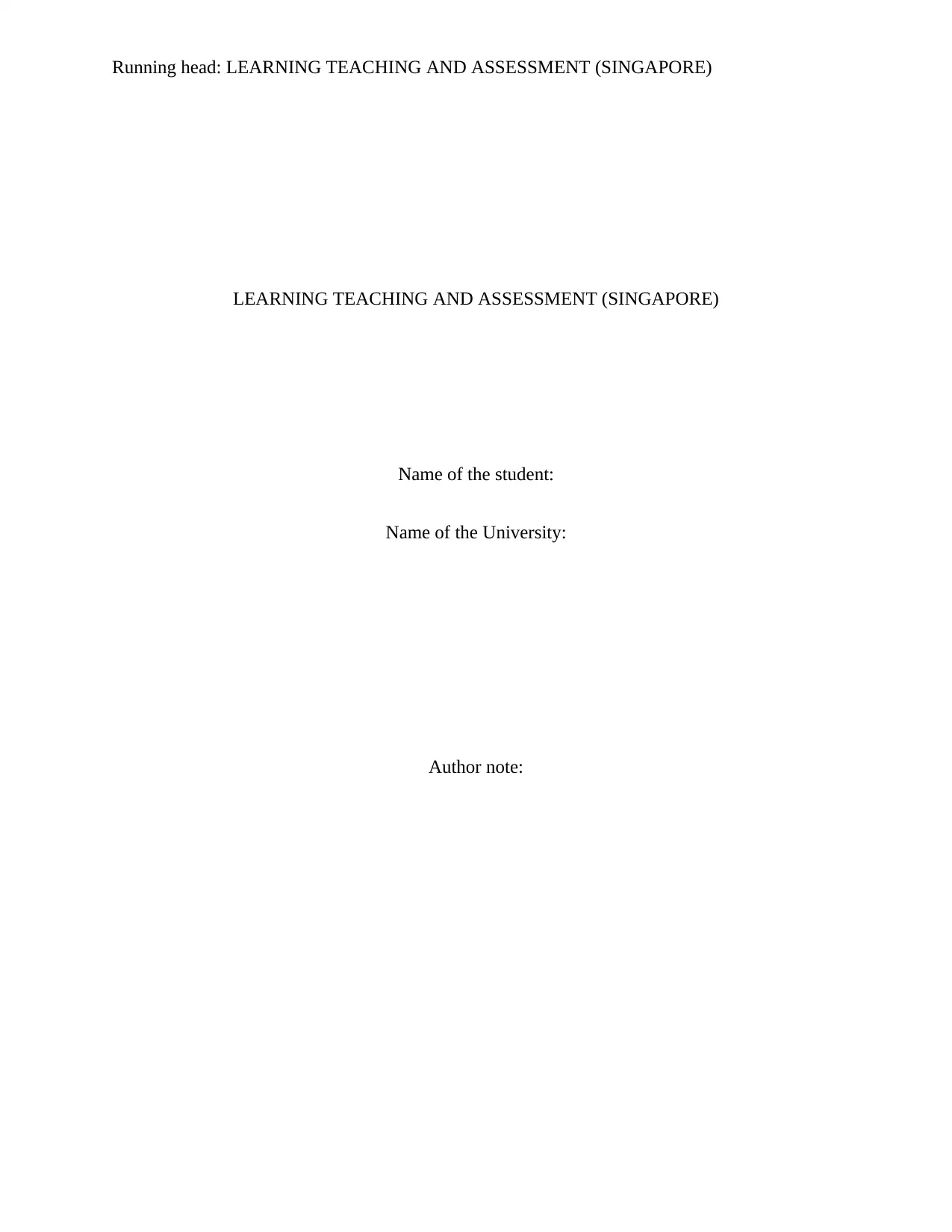
Running head: LEARNING TEACHING AND ASSESSMENT (SINGAPORE)
LEARNING TEACHING AND ASSESSMENT (SINGAPORE)
Name of the student:
Name of the University:
Author note:
LEARNING TEACHING AND ASSESSMENT (SINGAPORE)
Name of the student:
Name of the University:
Author note:
Paraphrase This Document
Need a fresh take? Get an instant paraphrase of this document with our AI Paraphraser
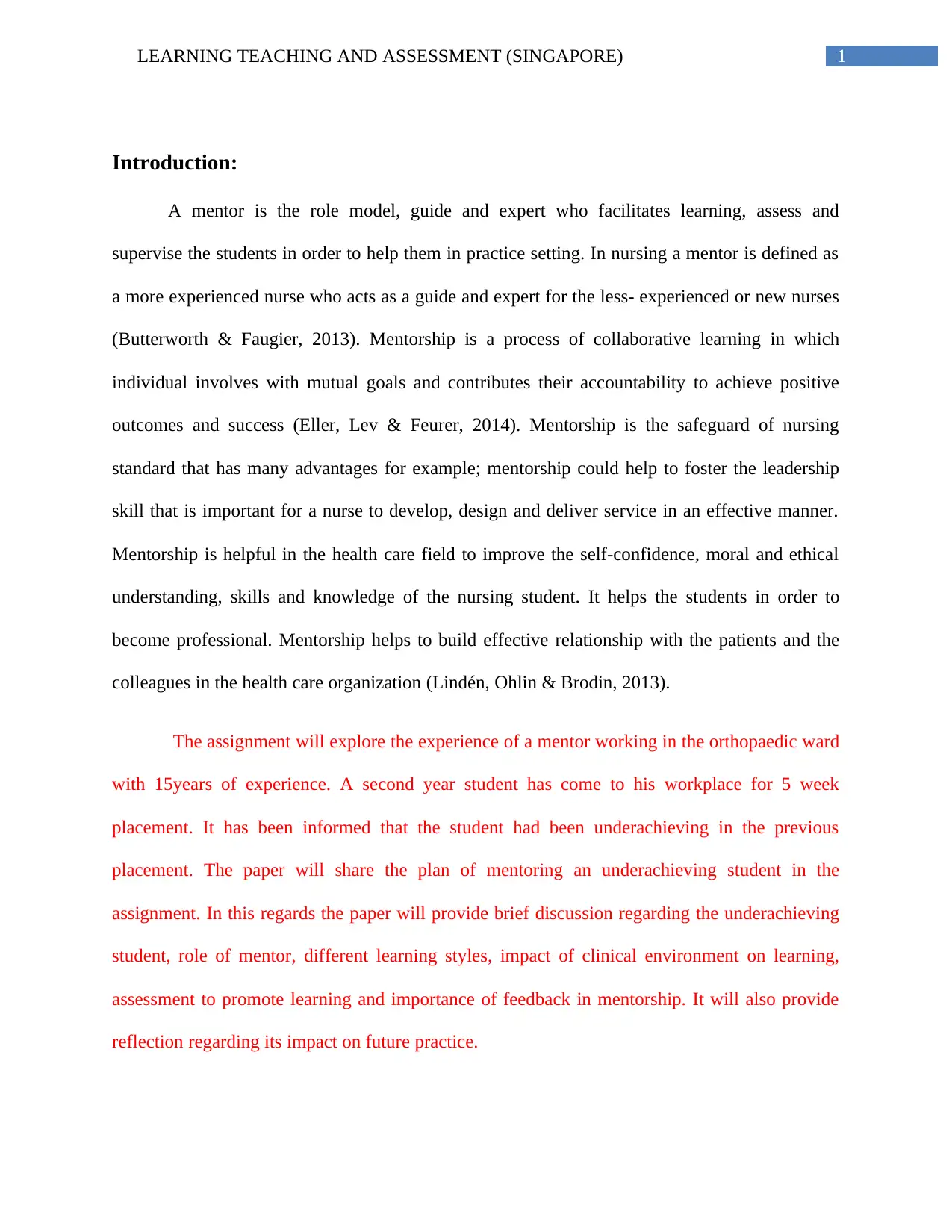
1LEARNING TEACHING AND ASSESSMENT (SINGAPORE)
Introduction:
A mentor is the role model, guide and expert who facilitates learning, assess and
supervise the students in order to help them in practice setting. In nursing a mentor is defined as
a more experienced nurse who acts as a guide and expert for the less- experienced or new nurses
(Butterworth & Faugier, 2013). Mentorship is a process of collaborative learning in which
individual involves with mutual goals and contributes their accountability to achieve positive
outcomes and success (Eller, Lev & Feurer, 2014). Mentorship is the safeguard of nursing
standard that has many advantages for example; mentorship could help to foster the leadership
skill that is important for a nurse to develop, design and deliver service in an effective manner.
Mentorship is helpful in the health care field to improve the self-confidence, moral and ethical
understanding, skills and knowledge of the nursing student. It helps the students in order to
become professional. Mentorship helps to build effective relationship with the patients and the
colleagues in the health care organization (Lindén, Ohlin & Brodin, 2013).
The assignment will explore the experience of a mentor working in the orthopaedic ward
with 15years of experience. A second year student has come to his workplace for 5 week
placement. It has been informed that the student had been underachieving in the previous
placement. The paper will share the plan of mentoring an underachieving student in the
assignment. In this regards the paper will provide brief discussion regarding the underachieving
student, role of mentor, different learning styles, impact of clinical environment on learning,
assessment to promote learning and importance of feedback in mentorship. It will also provide
reflection regarding its impact on future practice.
Introduction:
A mentor is the role model, guide and expert who facilitates learning, assess and
supervise the students in order to help them in practice setting. In nursing a mentor is defined as
a more experienced nurse who acts as a guide and expert for the less- experienced or new nurses
(Butterworth & Faugier, 2013). Mentorship is a process of collaborative learning in which
individual involves with mutual goals and contributes their accountability to achieve positive
outcomes and success (Eller, Lev & Feurer, 2014). Mentorship is the safeguard of nursing
standard that has many advantages for example; mentorship could help to foster the leadership
skill that is important for a nurse to develop, design and deliver service in an effective manner.
Mentorship is helpful in the health care field to improve the self-confidence, moral and ethical
understanding, skills and knowledge of the nursing student. It helps the students in order to
become professional. Mentorship helps to build effective relationship with the patients and the
colleagues in the health care organization (Lindén, Ohlin & Brodin, 2013).
The assignment will explore the experience of a mentor working in the orthopaedic ward
with 15years of experience. A second year student has come to his workplace for 5 week
placement. It has been informed that the student had been underachieving in the previous
placement. The paper will share the plan of mentoring an underachieving student in the
assignment. In this regards the paper will provide brief discussion regarding the underachieving
student, role of mentor, different learning styles, impact of clinical environment on learning,
assessment to promote learning and importance of feedback in mentorship. It will also provide
reflection regarding its impact on future practice.
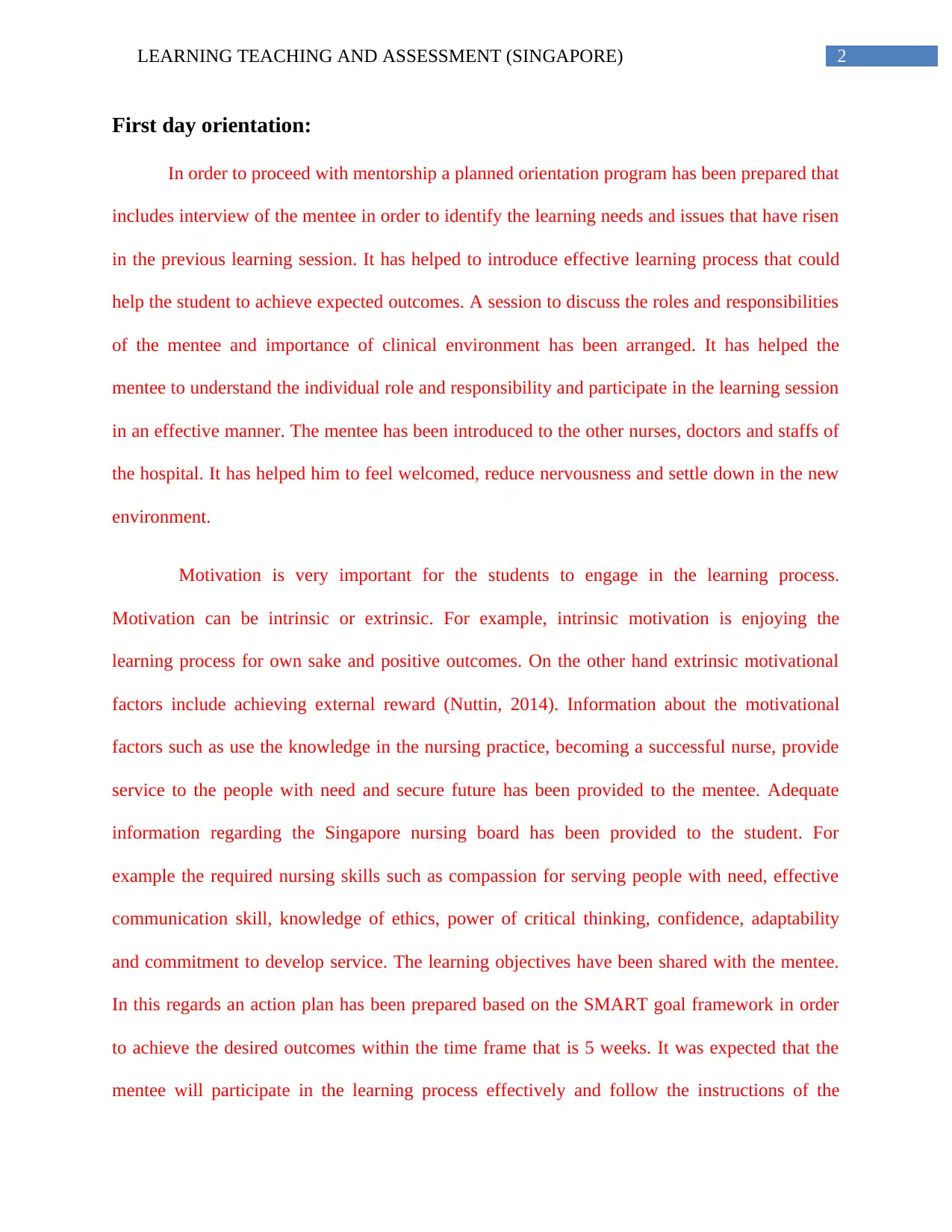
2LEARNING TEACHING AND ASSESSMENT (SINGAPORE)
First day orientation:
In order to proceed with mentorship a planned orientation program has been prepared that
includes interview of the mentee in order to identify the learning needs and issues that have risen
in the previous learning session. It has helped to introduce effective learning process that could
help the student to achieve expected outcomes. A session to discuss the roles and responsibilities
of the mentee and importance of clinical environment has been arranged. It has helped the
mentee to understand the individual role and responsibility and participate in the learning session
in an effective manner. The mentee has been introduced to the other nurses, doctors and staffs of
the hospital. It has helped him to feel welcomed, reduce nervousness and settle down in the new
environment.
Motivation is very important for the students to engage in the learning process.
Motivation can be intrinsic or extrinsic. For example, intrinsic motivation is enjoying the
learning process for own sake and positive outcomes. On the other hand extrinsic motivational
factors include achieving external reward (Nuttin, 2014). Information about the motivational
factors such as use the knowledge in the nursing practice, becoming a successful nurse, provide
service to the people with need and secure future has been provided to the mentee. Adequate
information regarding the Singapore nursing board has been provided to the student. For
example the required nursing skills such as compassion for serving people with need, effective
communication skill, knowledge of ethics, power of critical thinking, confidence, adaptability
and commitment to develop service. The learning objectives have been shared with the mentee.
In this regards an action plan has been prepared based on the SMART goal framework in order
to achieve the desired outcomes within the time frame that is 5 weeks. It was expected that the
mentee will participate in the learning process effectively and follow the instructions of the
First day orientation:
In order to proceed with mentorship a planned orientation program has been prepared that
includes interview of the mentee in order to identify the learning needs and issues that have risen
in the previous learning session. It has helped to introduce effective learning process that could
help the student to achieve expected outcomes. A session to discuss the roles and responsibilities
of the mentee and importance of clinical environment has been arranged. It has helped the
mentee to understand the individual role and responsibility and participate in the learning session
in an effective manner. The mentee has been introduced to the other nurses, doctors and staffs of
the hospital. It has helped him to feel welcomed, reduce nervousness and settle down in the new
environment.
Motivation is very important for the students to engage in the learning process.
Motivation can be intrinsic or extrinsic. For example, intrinsic motivation is enjoying the
learning process for own sake and positive outcomes. On the other hand extrinsic motivational
factors include achieving external reward (Nuttin, 2014). Information about the motivational
factors such as use the knowledge in the nursing practice, becoming a successful nurse, provide
service to the people with need and secure future has been provided to the mentee. Adequate
information regarding the Singapore nursing board has been provided to the student. For
example the required nursing skills such as compassion for serving people with need, effective
communication skill, knowledge of ethics, power of critical thinking, confidence, adaptability
and commitment to develop service. The learning objectives have been shared with the mentee.
In this regards an action plan has been prepared based on the SMART goal framework in order
to achieve the desired outcomes within the time frame that is 5 weeks. It was expected that the
mentee will participate in the learning process effectively and follow the instructions of the
⊘ This is a preview!⊘
Do you want full access?
Subscribe today to unlock all pages.

Trusted by 1+ million students worldwide
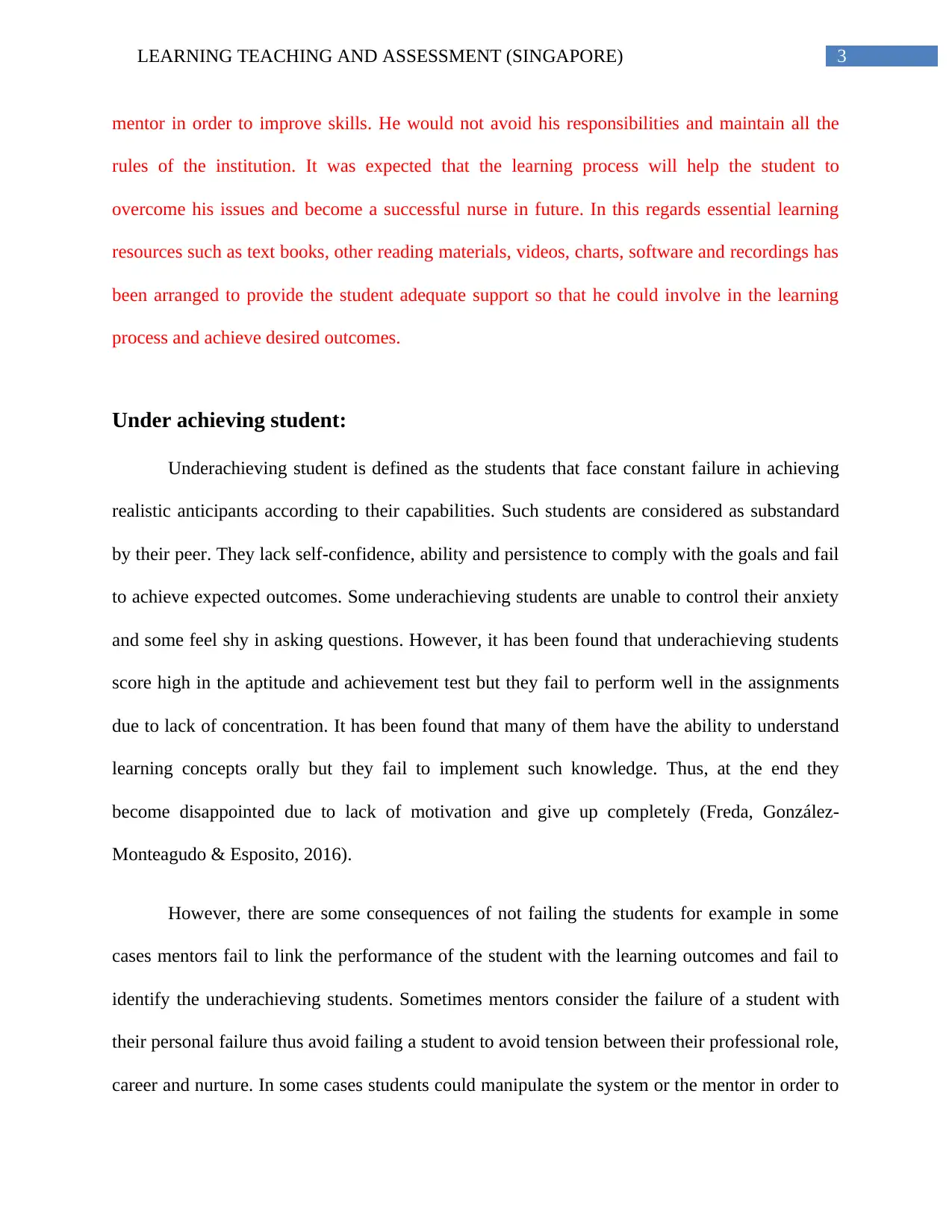
3LEARNING TEACHING AND ASSESSMENT (SINGAPORE)
mentor in order to improve skills. He would not avoid his responsibilities and maintain all the
rules of the institution. It was expected that the learning process will help the student to
overcome his issues and become a successful nurse in future. In this regards essential learning
resources such as text books, other reading materials, videos, charts, software and recordings has
been arranged to provide the student adequate support so that he could involve in the learning
process and achieve desired outcomes.
Under achieving student:
Underachieving student is defined as the students that face constant failure in achieving
realistic anticipants according to their capabilities. Such students are considered as substandard
by their peer. They lack self-confidence, ability and persistence to comply with the goals and fail
to achieve expected outcomes. Some underachieving students are unable to control their anxiety
and some feel shy in asking questions. However, it has been found that underachieving students
score high in the aptitude and achievement test but they fail to perform well in the assignments
due to lack of concentration. It has been found that many of them have the ability to understand
learning concepts orally but they fail to implement such knowledge. Thus, at the end they
become disappointed due to lack of motivation and give up completely (Freda, González-
Monteagudo & Esposito, 2016).
However, there are some consequences of not failing the students for example in some
cases mentors fail to link the performance of the student with the learning outcomes and fail to
identify the underachieving students. Sometimes mentors consider the failure of a student with
their personal failure thus avoid failing a student to avoid tension between their professional role,
career and nurture. In some cases students could manipulate the system or the mentor in order to
mentor in order to improve skills. He would not avoid his responsibilities and maintain all the
rules of the institution. It was expected that the learning process will help the student to
overcome his issues and become a successful nurse in future. In this regards essential learning
resources such as text books, other reading materials, videos, charts, software and recordings has
been arranged to provide the student adequate support so that he could involve in the learning
process and achieve desired outcomes.
Under achieving student:
Underachieving student is defined as the students that face constant failure in achieving
realistic anticipants according to their capabilities. Such students are considered as substandard
by their peer. They lack self-confidence, ability and persistence to comply with the goals and fail
to achieve expected outcomes. Some underachieving students are unable to control their anxiety
and some feel shy in asking questions. However, it has been found that underachieving students
score high in the aptitude and achievement test but they fail to perform well in the assignments
due to lack of concentration. It has been found that many of them have the ability to understand
learning concepts orally but they fail to implement such knowledge. Thus, at the end they
become disappointed due to lack of motivation and give up completely (Freda, González-
Monteagudo & Esposito, 2016).
However, there are some consequences of not failing the students for example in some
cases mentors fail to link the performance of the student with the learning outcomes and fail to
identify the underachieving students. Sometimes mentors consider the failure of a student with
their personal failure thus avoid failing a student to avoid tension between their professional role,
career and nurture. In some cases students could manipulate the system or the mentor in order to
Paraphrase This Document
Need a fresh take? Get an instant paraphrase of this document with our AI Paraphraser
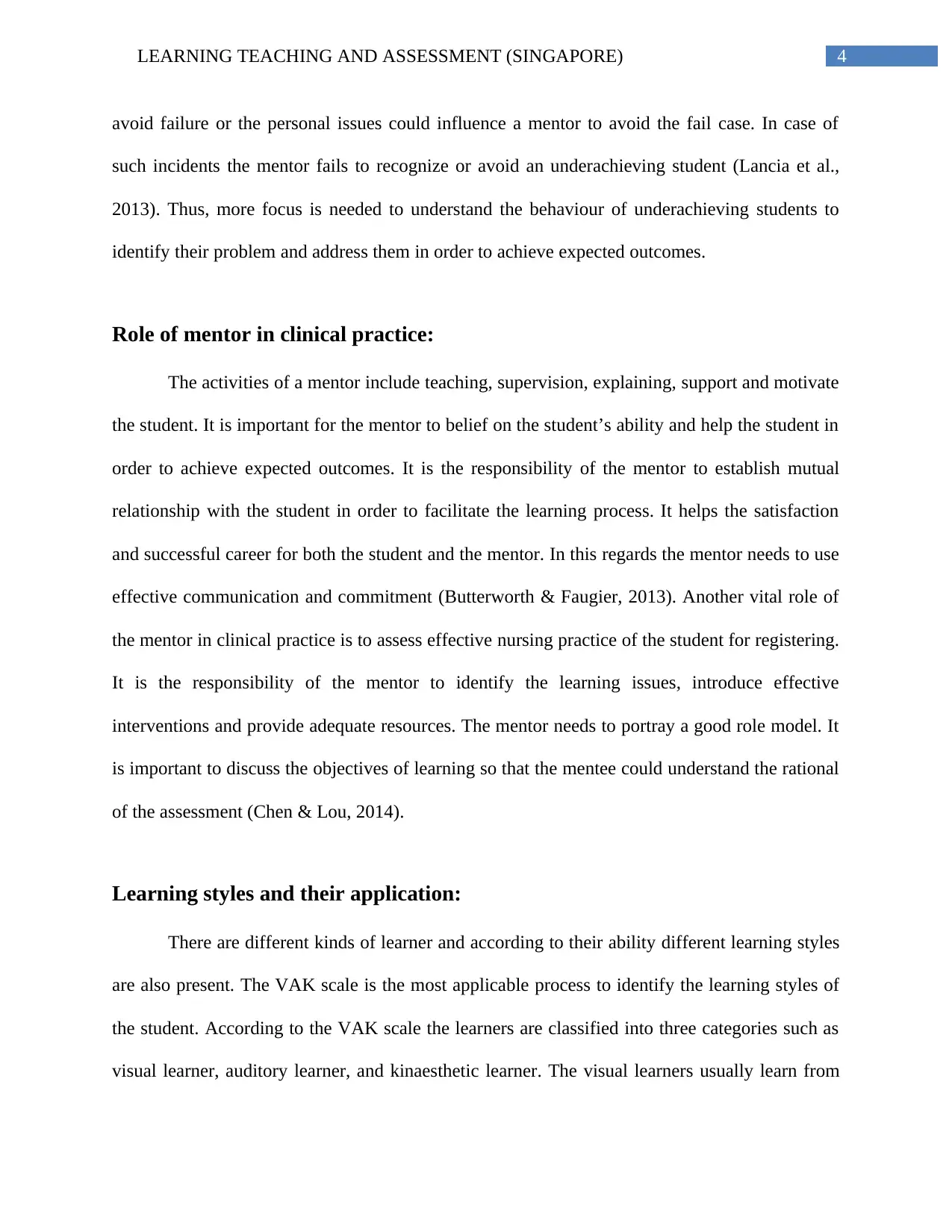
4LEARNING TEACHING AND ASSESSMENT (SINGAPORE)
avoid failure or the personal issues could influence a mentor to avoid the fail case. In case of
such incidents the mentor fails to recognize or avoid an underachieving student (Lancia et al.,
2013). Thus, more focus is needed to understand the behaviour of underachieving students to
identify their problem and address them in order to achieve expected outcomes.
Role of mentor in clinical practice:
The activities of a mentor include teaching, supervision, explaining, support and motivate
the student. It is important for the mentor to belief on the student’s ability and help the student in
order to achieve expected outcomes. It is the responsibility of the mentor to establish mutual
relationship with the student in order to facilitate the learning process. It helps the satisfaction
and successful career for both the student and the mentor. In this regards the mentor needs to use
effective communication and commitment (Butterworth & Faugier, 2013). Another vital role of
the mentor in clinical practice is to assess effective nursing practice of the student for registering.
It is the responsibility of the mentor to identify the learning issues, introduce effective
interventions and provide adequate resources. The mentor needs to portray a good role model. It
is important to discuss the objectives of learning so that the mentee could understand the rational
of the assessment (Chen & Lou, 2014).
Learning styles and their application:
There are different kinds of learner and according to their ability different learning styles
are also present. The VAK scale is the most applicable process to identify the learning styles of
the student. According to the VAK scale the learners are classified into three categories such as
visual learner, auditory learner, and kinaesthetic learner. The visual learners usually learn from
avoid failure or the personal issues could influence a mentor to avoid the fail case. In case of
such incidents the mentor fails to recognize or avoid an underachieving student (Lancia et al.,
2013). Thus, more focus is needed to understand the behaviour of underachieving students to
identify their problem and address them in order to achieve expected outcomes.
Role of mentor in clinical practice:
The activities of a mentor include teaching, supervision, explaining, support and motivate
the student. It is important for the mentor to belief on the student’s ability and help the student in
order to achieve expected outcomes. It is the responsibility of the mentor to establish mutual
relationship with the student in order to facilitate the learning process. It helps the satisfaction
and successful career for both the student and the mentor. In this regards the mentor needs to use
effective communication and commitment (Butterworth & Faugier, 2013). Another vital role of
the mentor in clinical practice is to assess effective nursing practice of the student for registering.
It is the responsibility of the mentor to identify the learning issues, introduce effective
interventions and provide adequate resources. The mentor needs to portray a good role model. It
is important to discuss the objectives of learning so that the mentee could understand the rational
of the assessment (Chen & Lou, 2014).
Learning styles and their application:
There are different kinds of learner and according to their ability different learning styles
are also present. The VAK scale is the most applicable process to identify the learning styles of
the student. According to the VAK scale the learners are classified into three categories such as
visual learner, auditory learner, and kinaesthetic learner. The visual learners usually learn from
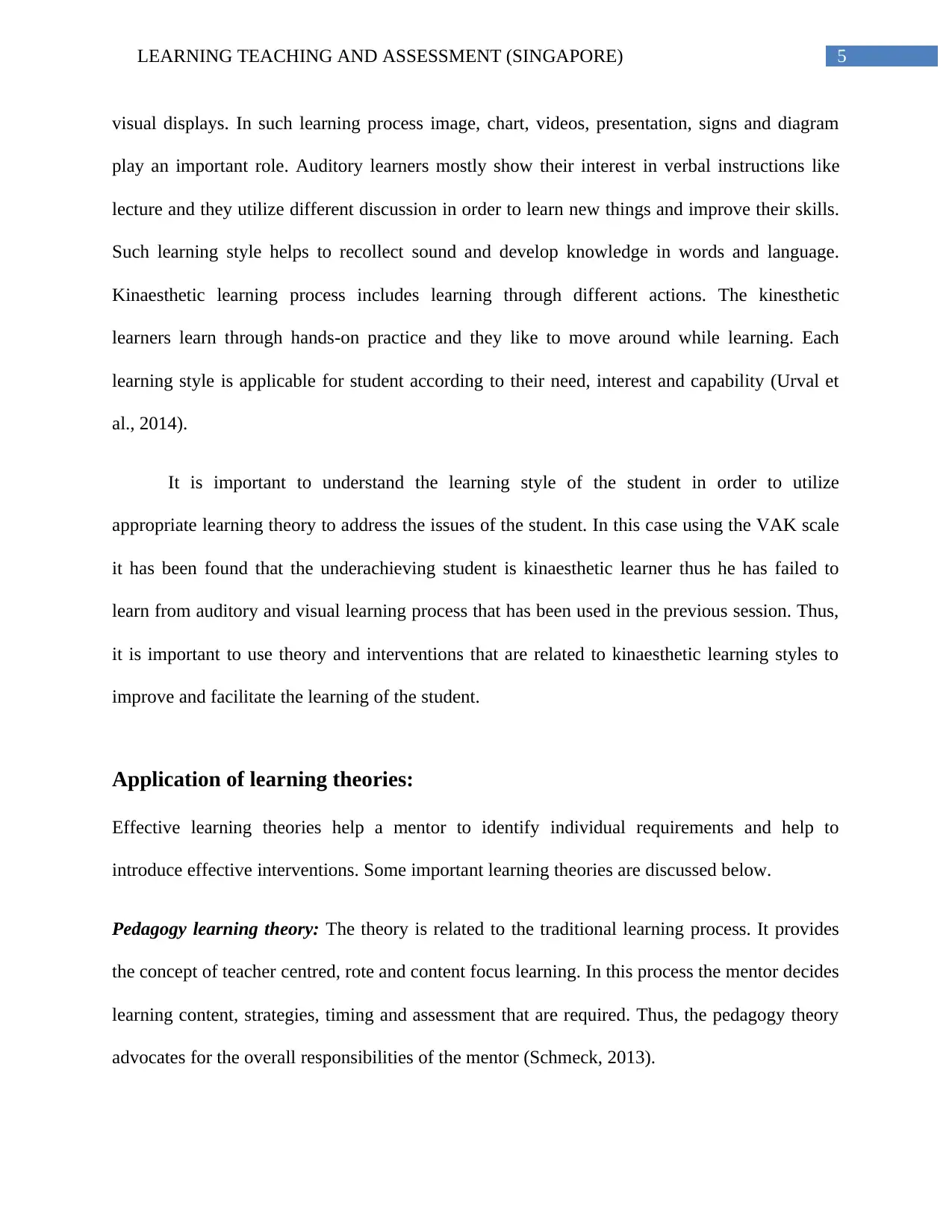
5LEARNING TEACHING AND ASSESSMENT (SINGAPORE)
visual displays. In such learning process image, chart, videos, presentation, signs and diagram
play an important role. Auditory learners mostly show their interest in verbal instructions like
lecture and they utilize different discussion in order to learn new things and improve their skills.
Such learning style helps to recollect sound and develop knowledge in words and language.
Kinaesthetic learning process includes learning through different actions. The kinesthetic
learners learn through hands-on practice and they like to move around while learning. Each
learning style is applicable for student according to their need, interest and capability (Urval et
al., 2014).
It is important to understand the learning style of the student in order to utilize
appropriate learning theory to address the issues of the student. In this case using the VAK scale
it has been found that the underachieving student is kinaesthetic learner thus he has failed to
learn from auditory and visual learning process that has been used in the previous session. Thus,
it is important to use theory and interventions that are related to kinaesthetic learning styles to
improve and facilitate the learning of the student.
Application of learning theories:
Effective learning theories help a mentor to identify individual requirements and help to
introduce effective interventions. Some important learning theories are discussed below.
Pedagogy learning theory: The theory is related to the traditional learning process. It provides
the concept of teacher centred, rote and content focus learning. In this process the mentor decides
learning content, strategies, timing and assessment that are required. Thus, the pedagogy theory
advocates for the overall responsibilities of the mentor (Schmeck, 2013).
visual displays. In such learning process image, chart, videos, presentation, signs and diagram
play an important role. Auditory learners mostly show their interest in verbal instructions like
lecture and they utilize different discussion in order to learn new things and improve their skills.
Such learning style helps to recollect sound and develop knowledge in words and language.
Kinaesthetic learning process includes learning through different actions. The kinesthetic
learners learn through hands-on practice and they like to move around while learning. Each
learning style is applicable for student according to their need, interest and capability (Urval et
al., 2014).
It is important to understand the learning style of the student in order to utilize
appropriate learning theory to address the issues of the student. In this case using the VAK scale
it has been found that the underachieving student is kinaesthetic learner thus he has failed to
learn from auditory and visual learning process that has been used in the previous session. Thus,
it is important to use theory and interventions that are related to kinaesthetic learning styles to
improve and facilitate the learning of the student.
Application of learning theories:
Effective learning theories help a mentor to identify individual requirements and help to
introduce effective interventions. Some important learning theories are discussed below.
Pedagogy learning theory: The theory is related to the traditional learning process. It provides
the concept of teacher centred, rote and content focus learning. In this process the mentor decides
learning content, strategies, timing and assessment that are required. Thus, the pedagogy theory
advocates for the overall responsibilities of the mentor (Schmeck, 2013).
⊘ This is a preview!⊘
Do you want full access?
Subscribe today to unlock all pages.

Trusted by 1+ million students worldwide
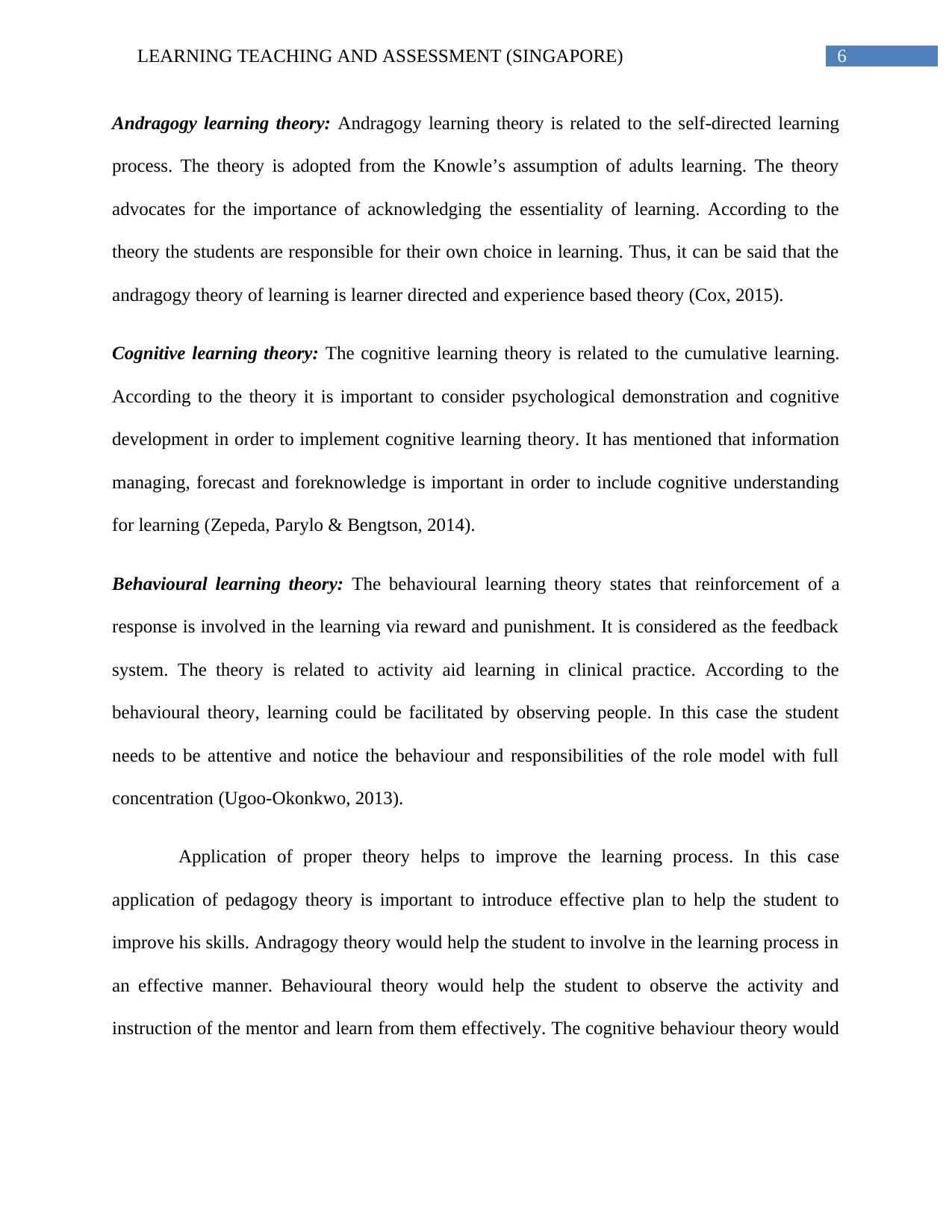
6LEARNING TEACHING AND ASSESSMENT (SINGAPORE)
Andragogy learning theory: Andragogy learning theory is related to the self-directed learning
process. The theory is adopted from the Knowle’s assumption of adults learning. The theory
advocates for the importance of acknowledging the essentiality of learning. According to the
theory the students are responsible for their own choice in learning. Thus, it can be said that the
andragogy theory of learning is learner directed and experience based theory (Cox, 2015).
Cognitive learning theory: The cognitive learning theory is related to the cumulative learning.
According to the theory it is important to consider psychological demonstration and cognitive
development in order to implement cognitive learning theory. It has mentioned that information
managing, forecast and foreknowledge is important in order to include cognitive understanding
for learning (Zepeda, Parylo & Bengtson, 2014).
Behavioural learning theory: The behavioural learning theory states that reinforcement of a
response is involved in the learning via reward and punishment. It is considered as the feedback
system. The theory is related to activity aid learning in clinical practice. According to the
behavioural theory, learning could be facilitated by observing people. In this case the student
needs to be attentive and notice the behaviour and responsibilities of the role model with full
concentration (Ugoo-Okonkwo, 2013).
Application of proper theory helps to improve the learning process. In this case
application of pedagogy theory is important to introduce effective plan to help the student to
improve his skills. Andragogy theory would help the student to involve in the learning process in
an effective manner. Behavioural theory would help the student to observe the activity and
instruction of the mentor and learn from them effectively. The cognitive behaviour theory would
Andragogy learning theory: Andragogy learning theory is related to the self-directed learning
process. The theory is adopted from the Knowle’s assumption of adults learning. The theory
advocates for the importance of acknowledging the essentiality of learning. According to the
theory the students are responsible for their own choice in learning. Thus, it can be said that the
andragogy theory of learning is learner directed and experience based theory (Cox, 2015).
Cognitive learning theory: The cognitive learning theory is related to the cumulative learning.
According to the theory it is important to consider psychological demonstration and cognitive
development in order to implement cognitive learning theory. It has mentioned that information
managing, forecast and foreknowledge is important in order to include cognitive understanding
for learning (Zepeda, Parylo & Bengtson, 2014).
Behavioural learning theory: The behavioural learning theory states that reinforcement of a
response is involved in the learning via reward and punishment. It is considered as the feedback
system. The theory is related to activity aid learning in clinical practice. According to the
behavioural theory, learning could be facilitated by observing people. In this case the student
needs to be attentive and notice the behaviour and responsibilities of the role model with full
concentration (Ugoo-Okonkwo, 2013).
Application of proper theory helps to improve the learning process. In this case
application of pedagogy theory is important to introduce effective plan to help the student to
improve his skills. Andragogy theory would help the student to involve in the learning process in
an effective manner. Behavioural theory would help the student to observe the activity and
instruction of the mentor and learn from them effectively. The cognitive behaviour theory would
Paraphrase This Document
Need a fresh take? Get an instant paraphrase of this document with our AI Paraphraser
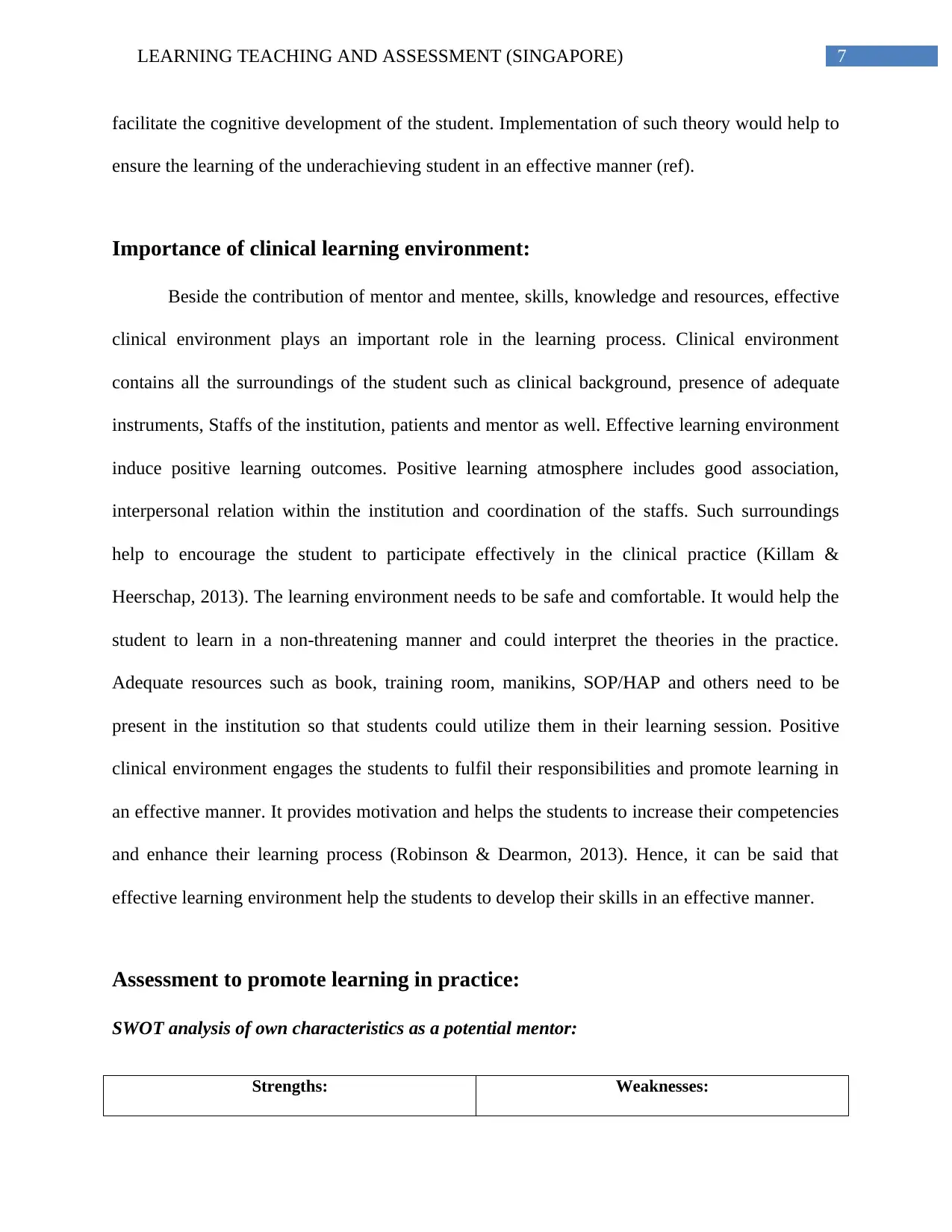
7LEARNING TEACHING AND ASSESSMENT (SINGAPORE)
facilitate the cognitive development of the student. Implementation of such theory would help to
ensure the learning of the underachieving student in an effective manner (ref).
Importance of clinical learning environment:
Beside the contribution of mentor and mentee, skills, knowledge and resources, effective
clinical environment plays an important role in the learning process. Clinical environment
contains all the surroundings of the student such as clinical background, presence of adequate
instruments, Staffs of the institution, patients and mentor as well. Effective learning environment
induce positive learning outcomes. Positive learning atmosphere includes good association,
interpersonal relation within the institution and coordination of the staffs. Such surroundings
help to encourage the student to participate effectively in the clinical practice (Killam &
Heerschap, 2013). The learning environment needs to be safe and comfortable. It would help the
student to learn in a non-threatening manner and could interpret the theories in the practice.
Adequate resources such as book, training room, manikins, SOP/HAP and others need to be
present in the institution so that students could utilize them in their learning session. Positive
clinical environment engages the students to fulfil their responsibilities and promote learning in
an effective manner. It provides motivation and helps the students to increase their competencies
and enhance their learning process (Robinson & Dearmon, 2013). Hence, it can be said that
effective learning environment help the students to develop their skills in an effective manner.
Assessment to promote learning in practice:
SWOT analysis of own characteristics as a potential mentor:
Strengths: Weaknesses:
facilitate the cognitive development of the student. Implementation of such theory would help to
ensure the learning of the underachieving student in an effective manner (ref).
Importance of clinical learning environment:
Beside the contribution of mentor and mentee, skills, knowledge and resources, effective
clinical environment plays an important role in the learning process. Clinical environment
contains all the surroundings of the student such as clinical background, presence of adequate
instruments, Staffs of the institution, patients and mentor as well. Effective learning environment
induce positive learning outcomes. Positive learning atmosphere includes good association,
interpersonal relation within the institution and coordination of the staffs. Such surroundings
help to encourage the student to participate effectively in the clinical practice (Killam &
Heerschap, 2013). The learning environment needs to be safe and comfortable. It would help the
student to learn in a non-threatening manner and could interpret the theories in the practice.
Adequate resources such as book, training room, manikins, SOP/HAP and others need to be
present in the institution so that students could utilize them in their learning session. Positive
clinical environment engages the students to fulfil their responsibilities and promote learning in
an effective manner. It provides motivation and helps the students to increase their competencies
and enhance their learning process (Robinson & Dearmon, 2013). Hence, it can be said that
effective learning environment help the students to develop their skills in an effective manner.
Assessment to promote learning in practice:
SWOT analysis of own characteristics as a potential mentor:
Strengths: Weaknesses:
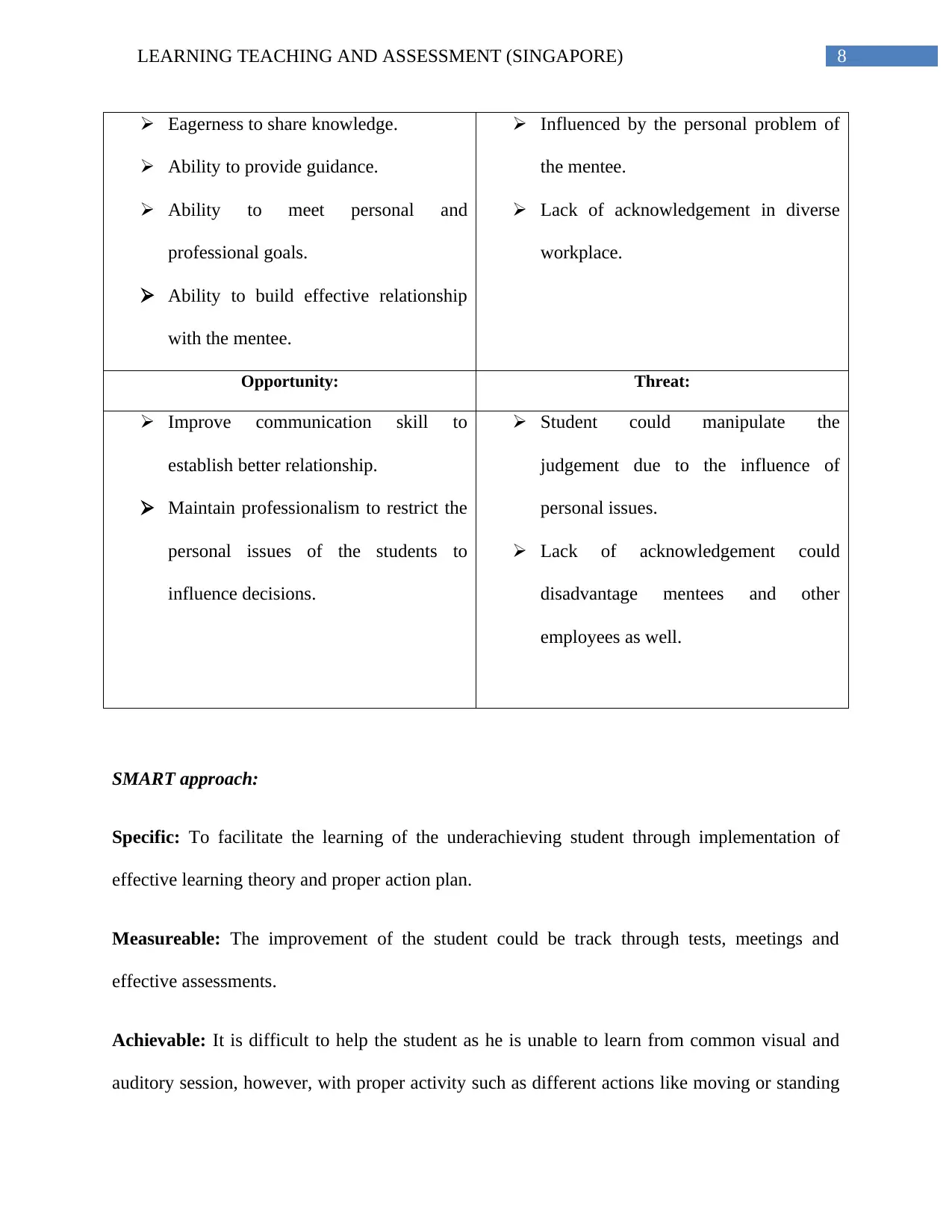
8LEARNING TEACHING AND ASSESSMENT (SINGAPORE)
Eagerness to share knowledge.
Ability to provide guidance.
Ability to meet personal and
professional goals.
Ability to build effective relationship
with the mentee.
Influenced by the personal problem of
the mentee.
Lack of acknowledgement in diverse
workplace.
Opportunity: Threat:
Improve communication skill to
establish better relationship.
Maintain professionalism to restrict the
personal issues of the students to
influence decisions.
Student could manipulate the
judgement due to the influence of
personal issues.
Lack of acknowledgement could
disadvantage mentees and other
employees as well.
SMART approach:
Specific: To facilitate the learning of the underachieving student through implementation of
effective learning theory and proper action plan.
Measureable: The improvement of the student could be track through tests, meetings and
effective assessments.
Achievable: It is difficult to help the student as he is unable to learn from common visual and
auditory session, however, with proper activity such as different actions like moving or standing
Eagerness to share knowledge.
Ability to provide guidance.
Ability to meet personal and
professional goals.
Ability to build effective relationship
with the mentee.
Influenced by the personal problem of
the mentee.
Lack of acknowledgement in diverse
workplace.
Opportunity: Threat:
Improve communication skill to
establish better relationship.
Maintain professionalism to restrict the
personal issues of the students to
influence decisions.
Student could manipulate the
judgement due to the influence of
personal issues.
Lack of acknowledgement could
disadvantage mentees and other
employees as well.
SMART approach:
Specific: To facilitate the learning of the underachieving student through implementation of
effective learning theory and proper action plan.
Measureable: The improvement of the student could be track through tests, meetings and
effective assessments.
Achievable: It is difficult to help the student as he is unable to learn from common visual and
auditory session, however, with proper activity such as different actions like moving or standing
⊘ This is a preview!⊘
Do you want full access?
Subscribe today to unlock all pages.

Trusted by 1+ million students worldwide
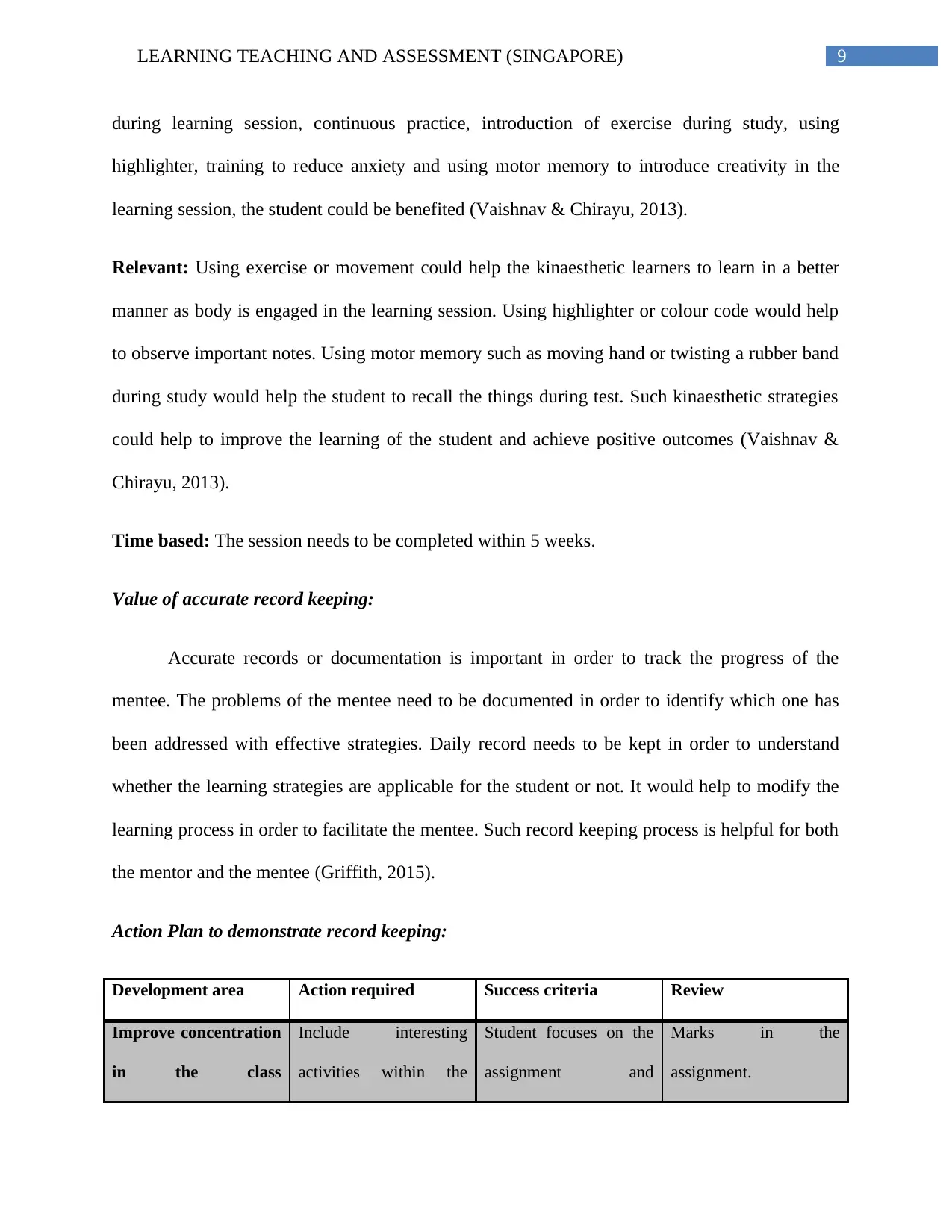
9LEARNING TEACHING AND ASSESSMENT (SINGAPORE)
during learning session, continuous practice, introduction of exercise during study, using
highlighter, training to reduce anxiety and using motor memory to introduce creativity in the
learning session, the student could be benefited (Vaishnav & Chirayu, 2013).
Relevant: Using exercise or movement could help the kinaesthetic learners to learn in a better
manner as body is engaged in the learning session. Using highlighter or colour code would help
to observe important notes. Using motor memory such as moving hand or twisting a rubber band
during study would help the student to recall the things during test. Such kinaesthetic strategies
could help to improve the learning of the student and achieve positive outcomes (Vaishnav &
Chirayu, 2013).
Time based: The session needs to be completed within 5 weeks.
Value of accurate record keeping:
Accurate records or documentation is important in order to track the progress of the
mentee. The problems of the mentee need to be documented in order to identify which one has
been addressed with effective strategies. Daily record needs to be kept in order to understand
whether the learning strategies are applicable for the student or not. It would help to modify the
learning process in order to facilitate the mentee. Such record keeping process is helpful for both
the mentor and the mentee (Griffith, 2015).
Action Plan to demonstrate record keeping:
Development area Action required Success criteria Review
Improve concentration
in the class
Include interesting
activities within the
Student focuses on the
assignment and
Marks in the
assignment.
during learning session, continuous practice, introduction of exercise during study, using
highlighter, training to reduce anxiety and using motor memory to introduce creativity in the
learning session, the student could be benefited (Vaishnav & Chirayu, 2013).
Relevant: Using exercise or movement could help the kinaesthetic learners to learn in a better
manner as body is engaged in the learning session. Using highlighter or colour code would help
to observe important notes. Using motor memory such as moving hand or twisting a rubber band
during study would help the student to recall the things during test. Such kinaesthetic strategies
could help to improve the learning of the student and achieve positive outcomes (Vaishnav &
Chirayu, 2013).
Time based: The session needs to be completed within 5 weeks.
Value of accurate record keeping:
Accurate records or documentation is important in order to track the progress of the
mentee. The problems of the mentee need to be documented in order to identify which one has
been addressed with effective strategies. Daily record needs to be kept in order to understand
whether the learning strategies are applicable for the student or not. It would help to modify the
learning process in order to facilitate the mentee. Such record keeping process is helpful for both
the mentor and the mentee (Griffith, 2015).
Action Plan to demonstrate record keeping:
Development area Action required Success criteria Review
Improve concentration
in the class
Include interesting
activities within the
Student focuses on the
assignment and
Marks in the
assignment.
Paraphrase This Document
Need a fresh take? Get an instant paraphrase of this document with our AI Paraphraser
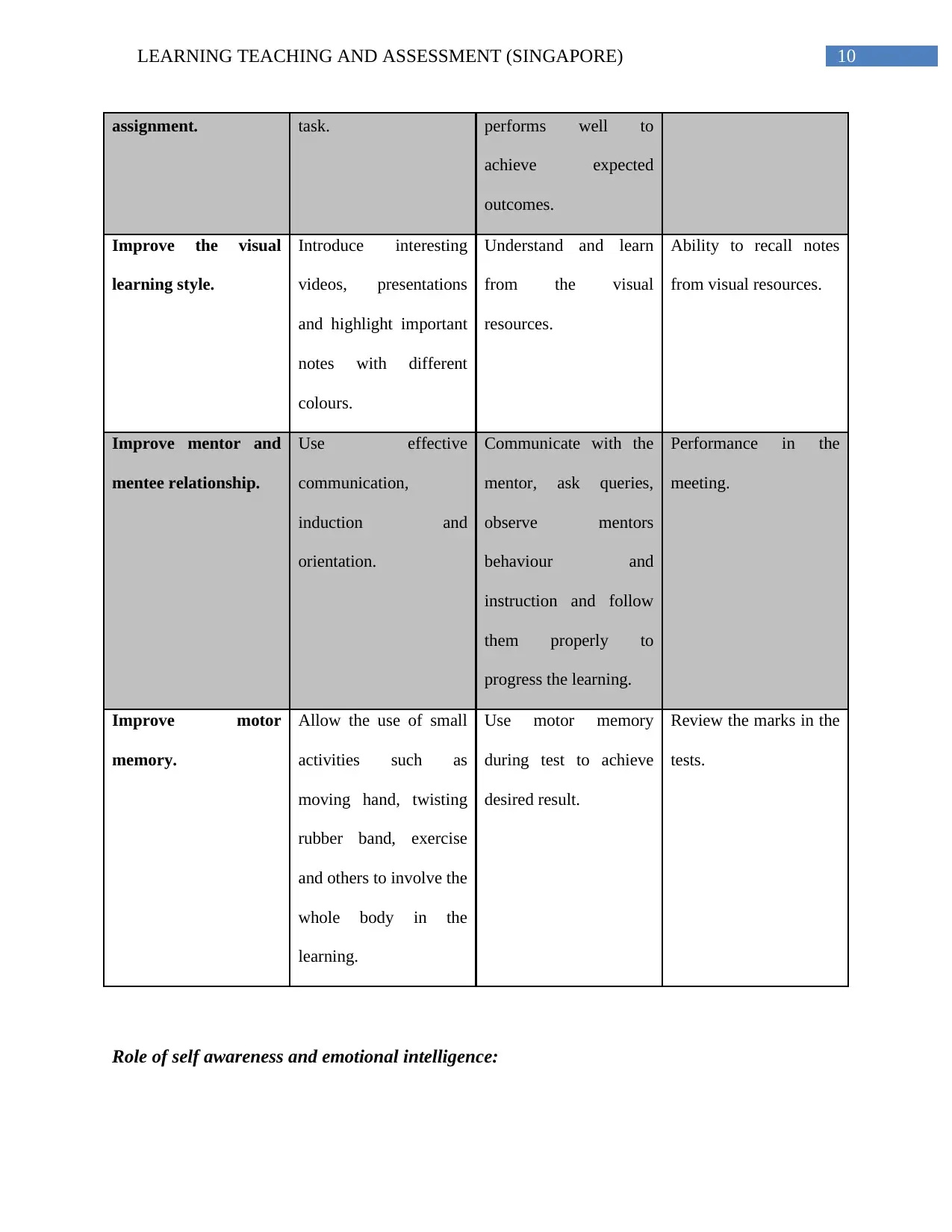
10LEARNING TEACHING AND ASSESSMENT (SINGAPORE)
assignment. task. performs well to
achieve expected
outcomes.
Improve the visual
learning style.
Introduce interesting
videos, presentations
and highlight important
notes with different
colours.
Understand and learn
from the visual
resources.
Ability to recall notes
from visual resources.
Improve mentor and
mentee relationship.
Use effective
communication,
induction and
orientation.
Communicate with the
mentor, ask queries,
observe mentors
behaviour and
instruction and follow
them properly to
progress the learning.
Performance in the
meeting.
Improve motor
memory.
Allow the use of small
activities such as
moving hand, twisting
rubber band, exercise
and others to involve the
whole body in the
learning.
Use motor memory
during test to achieve
desired result.
Review the marks in the
tests.
Role of self awareness and emotional intelligence:
assignment. task. performs well to
achieve expected
outcomes.
Improve the visual
learning style.
Introduce interesting
videos, presentations
and highlight important
notes with different
colours.
Understand and learn
from the visual
resources.
Ability to recall notes
from visual resources.
Improve mentor and
mentee relationship.
Use effective
communication,
induction and
orientation.
Communicate with the
mentor, ask queries,
observe mentors
behaviour and
instruction and follow
them properly to
progress the learning.
Performance in the
meeting.
Improve motor
memory.
Allow the use of small
activities such as
moving hand, twisting
rubber band, exercise
and others to involve the
whole body in the
learning.
Use motor memory
during test to achieve
desired result.
Review the marks in the
tests.
Role of self awareness and emotional intelligence:
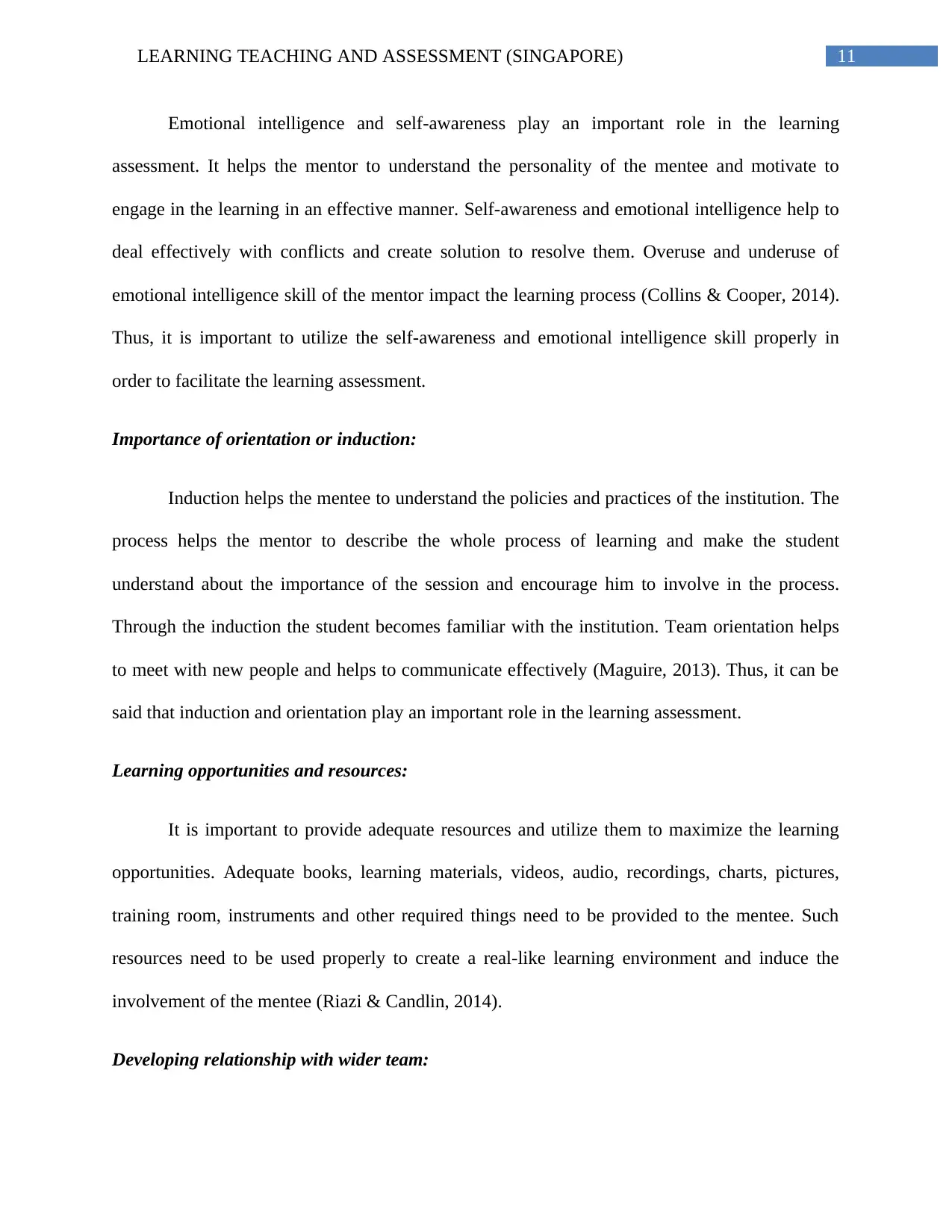
11LEARNING TEACHING AND ASSESSMENT (SINGAPORE)
Emotional intelligence and self-awareness play an important role in the learning
assessment. It helps the mentor to understand the personality of the mentee and motivate to
engage in the learning in an effective manner. Self-awareness and emotional intelligence help to
deal effectively with conflicts and create solution to resolve them. Overuse and underuse of
emotional intelligence skill of the mentor impact the learning process (Collins & Cooper, 2014).
Thus, it is important to utilize the self-awareness and emotional intelligence skill properly in
order to facilitate the learning assessment.
Importance of orientation or induction:
Induction helps the mentee to understand the policies and practices of the institution. The
process helps the mentor to describe the whole process of learning and make the student
understand about the importance of the session and encourage him to involve in the process.
Through the induction the student becomes familiar with the institution. Team orientation helps
to meet with new people and helps to communicate effectively (Maguire, 2013). Thus, it can be
said that induction and orientation play an important role in the learning assessment.
Learning opportunities and resources:
It is important to provide adequate resources and utilize them to maximize the learning
opportunities. Adequate books, learning materials, videos, audio, recordings, charts, pictures,
training room, instruments and other required things need to be provided to the mentee. Such
resources need to be used properly to create a real-like learning environment and induce the
involvement of the mentee (Riazi & Candlin, 2014).
Developing relationship with wider team:
Emotional intelligence and self-awareness play an important role in the learning
assessment. It helps the mentor to understand the personality of the mentee and motivate to
engage in the learning in an effective manner. Self-awareness and emotional intelligence help to
deal effectively with conflicts and create solution to resolve them. Overuse and underuse of
emotional intelligence skill of the mentor impact the learning process (Collins & Cooper, 2014).
Thus, it is important to utilize the self-awareness and emotional intelligence skill properly in
order to facilitate the learning assessment.
Importance of orientation or induction:
Induction helps the mentee to understand the policies and practices of the institution. The
process helps the mentor to describe the whole process of learning and make the student
understand about the importance of the session and encourage him to involve in the process.
Through the induction the student becomes familiar with the institution. Team orientation helps
to meet with new people and helps to communicate effectively (Maguire, 2013). Thus, it can be
said that induction and orientation play an important role in the learning assessment.
Learning opportunities and resources:
It is important to provide adequate resources and utilize them to maximize the learning
opportunities. Adequate books, learning materials, videos, audio, recordings, charts, pictures,
training room, instruments and other required things need to be provided to the mentee. Such
resources need to be used properly to create a real-like learning environment and induce the
involvement of the mentee (Riazi & Candlin, 2014).
Developing relationship with wider team:
⊘ This is a preview!⊘
Do you want full access?
Subscribe today to unlock all pages.

Trusted by 1+ million students worldwide
1 out of 21
Related Documents
Your All-in-One AI-Powered Toolkit for Academic Success.
+13062052269
info@desklib.com
Available 24*7 on WhatsApp / Email
![[object Object]](/_next/static/media/star-bottom.7253800d.svg)
Unlock your academic potential
Copyright © 2020–2025 A2Z Services. All Rights Reserved. Developed and managed by ZUCOL.





